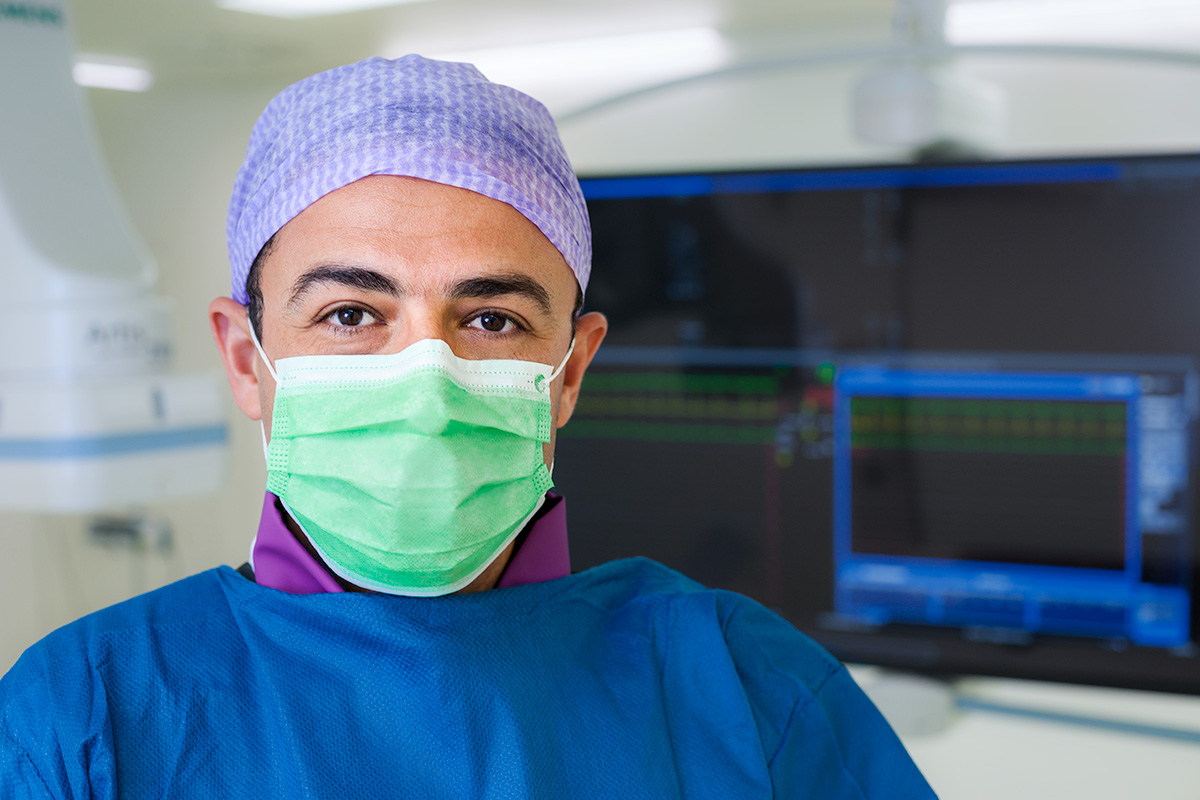Our treatment methods are based on minimally invasive techniques, making them easier on your body than conventional cardiac surgery. They are typically performed using a local anesthetic. Your recovery time will be much faster and you will be able to leave the clinic the same day.
Balloon Catheter
Balloon catheters can be used to treat narrowed blood vessels (stenosis)
and coronary heart disease (atherosclerosis). A thin, flexible catheter with a crimped balloon on its the tip is inserted through the groin region or the wrist. It is then advanced into the blocked artery and inflated, expanding the artery and eliminating the stenosis.
Stents
Stent treatment is a catheter-based method and therefore can reduce the strain placed on the body and reduce recovery time.
A narrowed or blocked coronary artery is first expanded using a balloon catheter. To keep the vessel from narrowing again, a metal called a stent is implanted in the affected vessel segment. This allows blood to circulate without any obstruction.
Modern stents called drug-eluting stents also release a small amount of medicine to maintain the long-term result inside the stent.
Patent Foramen Ovale (PFO)
The “foramen ovale” connects the heart’s two atria, and typically closes
shortly after birth. If it remains open, there is a risk that blood clots from the veins may enter the systemic bloodstream and possibly cause a stroke, a heart attack or occlusion of limb arteries.
PFO can now be closed by implanting an umbrella-shaped device. The device is inserted via the groin vein using a catheter.
Other types of shunt closure
There may be other types of open connections (shunts) inside the heart besides patent foramen ovale (PFO), including atrial septum defect (ASD), which forms between the two atria, or ventricular septum defect (VSD), which forms between the two ventricles. It is now possible to treat these kinds of shunts in most cases by implanting a closure device with the aid of a catheter – so that open heart surgery is not necessary.
Atrial Appendage Occlusion
The left atrial appendage is a small pouch normally found on the left atrium.
In patients with atrial fibrillation, blood clots can develop in the left atrial appendage. These clots can travel through the left ventricle up into the brain. If a clot blocks a cerebral artery there, it can cause a stroke. A special closure device is implanted in the left atrial appendage using a catheter via the groin vein. The occlusion achieved with the device abolishes this risk for patients with atrial fibrillation and eliminates the need for blood thinner medicines.
Transcatheter Aortic Valve Implantation (TAVI)
Transcatheter aortic valve implantation involves less risk than open heart surgery for valve replacement in patients with severe aortic valve stenosis.
With local anesthetic a catheter is used to advance a specially constructed heart valve directly to the heart at the location it is to be implanted via a groin artery. Unlike valve replacement surgery performed on an open heart, this minimally invasive procedure minimizes risk and significantly reduces recovery time.
Mitral Valve Reconstruction using the MitraClip Procedure
The MitraClip method is a cardiac catheterization procedure used to treat
the inability of the mitral valve to close without having to open the ribcage. A catheter with a clip affixed to its tip is advanced to the left atrium via the groin vein. The clip is positioned between the mitral valve leaflets using ultrasound monitoring. This keeps the valve from leaking and restores normal blood flow.
Pacemaker Implant
A pacemaker is able to detect and treat a slow heart rate (bradycardia). A
pacemaker can also be individually adjusted to match the needs of the patient. This involves passing one or two electrodes through a vein so they can be positioned right on the heart. The other ends of the electrodes are attached to the pacemaker (battery and electronics), which is implanted through a small incision under the skin and tucked away near the collar bone.
The pacemaker monitors whether the heartbeat is too fast, too slow or
irregular. It can stimulate the heart to restore a regular heartbeat. Arrhythmias are recorded and stored in ECGs. The data can then be wirelessly retrieved using a programming device for analysis.
Defibrillator Implantation (ICD)
An ICD (implantable cardioverter-defibrillator) is a more developed pacemaker that can also treat dangerous and fast arrhythmias such as
ventricular fibrillation in prone patients.
When an arrhythmia develops, the heart responds by emitting unnoticeable electric impulses that will in most cases be sufficient to take care of the problem. But if that is not enough to successfully stabilize the heartbeat, the ICD sends a high-energy impulse to slow the racing heartbeat within a few seconds. This impulse might feel painful, but it can also save your life in case of life-threatening arrhythmias (such as ventricular fibrillation).
Cardiac Resynchronization Therapy (CRT)
In certain types of heart failure, the (two) chambers of the heart are no longer in sync and cannot supply enough blood to the body. Many patients also have a disorder of the heart’s polarization system, which regulates the pumping action of the heart. CRT uses a standard pacemaker that has electrodes attached to both the right and left ventricles. This makes it possible to synchronize the stimulation they receive so that the heart pumps in sync, which would improve its pumping action.
Catheter Ablation
Ablation is an option when arrhythmias (e.g. atrial fibrillation) cannot be adequately controlled with medication. Points of pathological electrical
activity on the heart are first identified precisely (see EP) and then the tissue there is destroyed using a special catheter. After an ablation procedure the heart usually returns to its natural rhythm.

